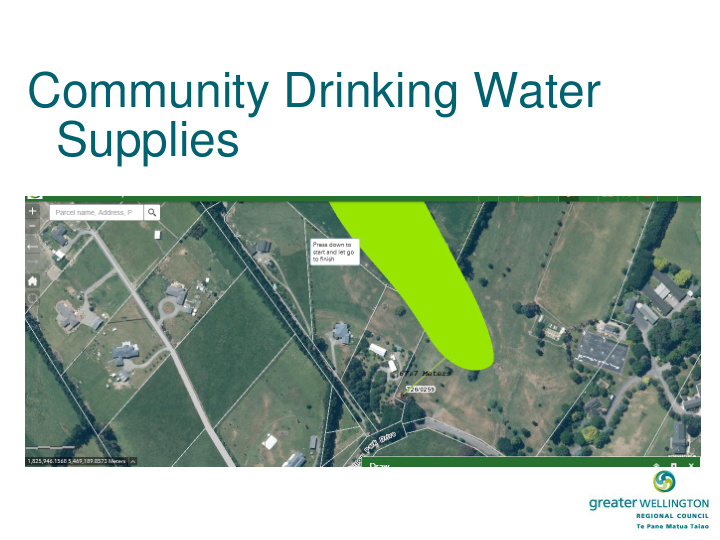



Community Drinking Water Supplies
• NES-HDWS requires GW to use precautionary approach to protect a community drinking water supply, i.e. avoid contamination rather than mitigating adverse effects e.g. attempting to treat contaminated drinking water. Consider cumulative effects of activities. • Have been issuing consents while implementing NES since 2012. The NES is not totally GW’s responsibility to implement.
• TAs & RPH also have statutory roles. • Water supply managers need to be aware of; – Threats to the quality of the water supply – Treatment capability they have – Contaminants they do, and should, test for – Minimum quality of source water required to meet treatment capability.
Processing applications for Discharge Permit or activities in CDWSPA and/or Group DWS areas • When assessing an application for an activity such as a discharge within a CDWSPA or upstream of a Group DWS intake, GW gathers and considers as much information as possible to undertake an assessment of risk to the water supply.
• We consider distance to abstraction point, activity and what design considerations have been used to minimise the risk of contaminants reaching water. • We ask the applicant if they have consulted with the CDW supplier, what concerns were raised and response. • In some cases we determine the CDWS supplier and RPH are affected persons.
• GW may consult with RPH and the CDWS supplier, or facilitate a meeting with all parties. • We seek information from the CDWS supplier on what contaminants the water supply is tested for, and what treatment occurs. • Each application has to be assessed individually as each situation is unique.
Case Study – On-Site Wastewater near a CDWS • Proposed residential development adjacent to Opaki Water Supply bore. MDC requested we assess whether proposed discharge would comply with permitted activity rule in operative Plan.
• GW determined that it did not meet permitted activity and resource consent was required. • Through consent process, risk to CDWS was assessed with input from RPH and the water supply operator along with MDC. • Shallow unconfined aquifer, stony free draining soils, close proximity to supply bore meant proposed discharge field type and siting was unsuitable.
• Opaki water supply was not treated so high risk of bacterial/viral contamination. • Land owners and MDC came up with an area of land downstream of bore that could be used for treated, shallow drip irrigation disposal fields for sections considered too close to bore. • Consent issued for discharge of sewage on separate lot specifically set aside for disposal field.
• Objectives, Policies and Rules as recommended to be amended in s42A Report would make more certain the approach in a similar situation today. • Imperative that the risk to a CDWS can be assessed under a restricted discretionary or discretionary activity process.
Case Study – Animal Effluent Discharge to Land
• New dairy shed and associated discharge applied for on expanded dairy farm. • Discharge area close proximity to Wainuioru Water Supply bores (CDWS). • Wainuioru WS already contaminated with nitrate levels occasionally over the NZ drinking water standard, and E.coli detections
• GW Groundwater staff asked to assess if discharge area would be classed as ‘upstream’ under the NES -SHDW definitions. Decision was made that it was not ‘upstream’ but there was still risk to water quality associated with proximity to bores • Applicant asked to detail what measures would be incorporated into the discharge system to limit hydraulic loading rates for the soils. • Walkover of the discharge area with the applicant to identify potential risk areas for his discharge.
• Consultation with RPH and the Water Supply Operator’s representative undertaken by GW as relationship between landowner and Water Supply Operator had broken down. • Water Supplier representative had unreasonable expectation to stop all discharge and stock access to areas above and around the water supply pipelines due to risk of breakage and contaminants entering reticulation system.
• Consent issued with additional conditions to those generally on controlled activity animal effluent discharge consents: – Requires soil moisture monitoring and discharge only when there is a corresponding soil moisture deficit; – Failsafe’s and alarms to be fitted to ensure no unauthorised discharges occur due to breakages/uncoupling of pipes and pump failures etc. • Water Supply Operator told to take responsibility for integrity of the delivery system
Recommend
More recommend